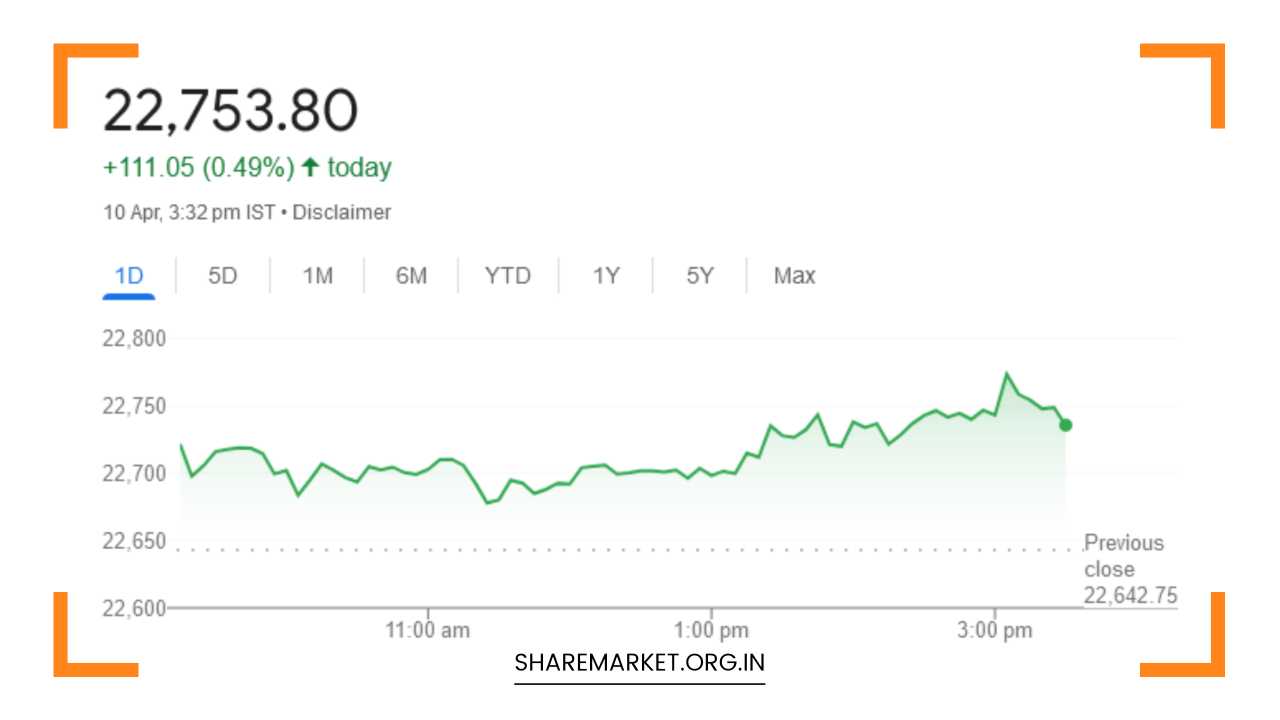Nifty Closed at 22,753; Nifty Prediction for Tomorrow

Nifty Prediction for Tomorrow
Indian Stock Market Soars: A Look Back, Forward, and Investor Considerations
Record-Breaking Rally Propels Sensex and Nifty to New Highs
The Indian stock market witnessed a phenomenal surge on April 10th, 2024, with both benchmark indices, Sensex and Nifty, reaching fresh record highs.
This positive momentum reflects continued investor confidence in the Indian economy’s long-term prospects.
However, understanding the nuances behind the rally and potential roadblocks is crucial for informed investment decisions.
Market Recap: April 10th, 2024 – A Day of Sectoral Strength
- Breaking Barriers: The 30-stock Sensex index closed at 75,038.15, gaining 354.45 points or 0.47%. The broader Nifty 50 index ended the day at 22,753.80, marking a gain of 111.00 points or 0.49%. Both indices achieved their highest closing levels ever.
- Sectoral Rotation: A noteworthy aspect was the dominance of positive movement across sectors. Almost all sectoral indices, barring Pharma, closed with significant gains ranging from 1% to 2%. Media, PSU Banks, FMCG, Metal, and Oil & Gas sectors were the major gainers, indicating a broad-based rally. This suggests investor interest is spreading beyond traditional favorites like IT and Pharma.
- Individual Stock Performance: The broader market sentiment remained positive, with 1761 shares advancing compared to 1617 declining ones. Coal India, BPCL, Kotak Mahindra Bank, ITC, and Hindalco Industries emerged as the top gainers on the Nifty, while Cipla, Maruti Suzuki, HDFC Life, Divis Labs, and SBI Life witnessed a decline. Stock selection within sectors becomes even more critical during such rotations.
- Currency Market: The Indian Rupee displayed strength, appreciating 12 paise to close at 83.19 per US Dollar. A stable or appreciating rupee can make investing in Indian stocks more attractive for foreign investors.
Analyst Views on Market Direction: Range-Bound or Further Rally?
Market experts provide valuable insights but may hold varying opinions on the market’s near-term trajectory:
- Rupak Dey, LKP Securities: He emphasizes the potential for a range-bound market in the short term due to investor focus on upcoming US inflation data, scheduled for release on April 12th. This data could influence the Federal Reserve’s interest rate decisions, impacting global liquidity and potentially the Indian markets. Resistance for Nifty is seen at 22,700-22,750, while support resides at 22,600. A breakout above 22,750 could propel Nifty towards 23,000. In this scenario, Dey recommends a “buy on dips, sell on rallies” strategy with stop-loss orders to manage risk.
- Aditya Gaggar, Progressive Shares: He highlights the positive cues from GIFT Nifty futures, which led to a strong opening for the Indian markets. Supported by gains in Banking and FMCG sectors, Nifty closed at a record high. The overall chart structure of Nifty 50 appears bullish, indicating a potential rise towards the psychological level of 23,000. Support for the index is expected around 22,530. Gaggar’s perspective leans towards a potential continuation of the rally.
Key Takeaways and Looking Ahead: Factors to Consider
- The Indian Growth Story: The strong performance highlights investor optimism about the domestic economy’s growth potential, driven by factors like increasing domestic consumption, government reforms, and a young demographic.
- Shifting Sectoral Preferences: Sectoral rotation is evident, with sectors beyond Pharma experiencing significant gains. This suggests a maturing market where investors are seeking opportunities across diverse industries.
- Global Cues: International market movements, particularly in the US and other major economies, will also influence investor behavior in India. Geopolitical tensions and global economic events can cause volatility.
- US Inflation Data: The release of US inflation data on April 12th will be a key factor driving market sentiment. Lower-than-expected inflation figures could bolster expectations of a dovish stance from the US Fed, potentially leading to further gains in the Indian markets.
- Company Earnings Season: The upcoming earnings season of Indian companies will provide further insights into corporate performance and future growth prospects, impacting stock prices.
Investor Strategy: Navigating the Market Landscape
- A Cautious Approach: Considering the potential volatility due to external factors like US inflation data and global cues, a cautious approach is recommended.
- Short-Term Strategies: Investors with a short-term horizon can consider a “buy on dips, sell on rallies” strategy with appropriate stop-loss orders to manage risk. This involves buying stocks when their prices fall slightly and selling them when they experience a temporary rise.
-
Long-Term Strategies: Long-term investors can focus on fundamentally strong companies with a proven track record and growth potential. These companies typically have strong financials, a competitive advantage in their industry, and a clear vision for the future. Analyzing a company’s financial statements, its competitive landscape, and its management team can help identify such long-term investment opportunities.
-
Diversification is Key: Diversifying across sectors and asset classes remains crucial for mitigating risk. This means not putting all your eggs in one basket. Invest in a variety of stocks across different sectors, such as technology, healthcare, consumer staples, and financials. Additionally, consider including other asset classes like bonds and real estate in your portfolio to further spread out your risk.
-
Stay Informed: Staying informed about market developments, company news, and global economic events is essential for making informed investment decisions. Utilize reputable financial news sources, research reports, and investment tools to stay updated on relevant information.
Beyond the Headlines: Additional Considerations for Investors
- Risk Tolerance: Understanding your risk tolerance is critical. How much risk are you comfortable taking on with your investments? Investors with a lower risk tolerance may choose to invest in a larger proportion of bonds or other less volatile assets.
- Investment Goals: Clearly define your investment goals. Are you saving for retirement, a child’s education, or a down payment on a house? Your investment timeframe and goals will influence your investment strategy.
- Professional Guidance: Consulting with a financial advisor can be beneficial, especially for new investors or those with complex financial situations. A qualified advisor can help you create a personalized investment plan aligned with your risk tolerance and goals.
Final Remarks: A Thriving Indian Market with Nuances
The Indian stock market’s recent surge reflects optimism about the country’s economic prospects. However, navigating this dynamic environment requires understanding the underlying factors driving the market, potential roadblocks like external data releases, and employing a well-defined investment strategy tailored to your individual circumstances.
By staying informed, adopting a prudent approach, and considering long-term fundamentals, investors can position themselves to potentially benefit from the ongoing growth in the Indian market.

















